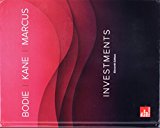
a.
To determine: The cost of restriction in terms of Sharpe’s measure
Introduction: The Sharpe ratio is used to measure the accumulated performance of an aggregate investment portfolio or an individual stock. It evaluates the performance of equity investment to the
a.
Answer to Problem 18PS
The cost of restriction in terms of Sharpe’s measure is in the cost
Explanation of Solution
Given Information:
Sharpe ratio is mostly used to measure the risk return. For this, first compute the expected
If the manager would not sell the securities he would consider only the stock A and C
| A | 1.6 | 3,364 | 0.00048 | 0.3352 |
| C | 3.4 | 3,600 | 0.00094 | 0.6648 |
| Total | 0.001420 | 1 |
The alpha of active portfolios,
The beta of active portfolio
So, the standard deviation of portfolio is,
The active risky portfolio,
The adjustment of beta,
The information ratio for the active portfolio,
The Sharpe ratio for the optimal portfolio,
Calculation of Beta,
The expected return,
The variance,
As, A = 2.8, the optimal position is calculated as,
So, the share per each asset is,
| BILLS | 1-0.5455 | 45.45% |
| MARKET | 0.5455x(1-0.0931) | 49.47% |
| A | 0.5455x (0.0931)x (0.3352) | 1.70% |
| C | 0.5455 x (0.0931)x (0.6648) | 3.38% |
| 100.00% |
b.
To determine: The utility loss to the investor in new complete portfolio
Introduction: The Sharpe ratio is used to measure the accumulated performance of an aggregate investment portfolio or an individual stock. It evaluates the performance of equity investment to the rate of return.
b.
Answer to Problem 18PS
The utility levels for the unconstrained, constrained and passive strategy are 10.40%, 10.23% and 10.16% respectively.
Explanation of Solution
Given Information:
Forecast returns, standard deviations and the beta values are given.
Sharpe ratio is mostly used to measure the risk return. For this, first compute the expected return on investment or individual stock, then subtract it from the risk free rate of return. Generally, when the ratio is greater than 1, it is considered as acceptable by the investors.
The variance and for passive strategy, the calculations are
| E ( R) | ||
| UNCONSRAINED STRATEGY | 4.79 | 170.95 |
| CONSTRAINED STRATEGY | 4.46 | 159.36 |
| PASSIVE STRATEGY | 4.32 | 154.31 |
By using the utility level formula,
Want to see more full solutions like this?
Chapter 8 Solutions
Investments, 11th Edition (exclude Access Card)
- Which of the following would be expected to hold its value best during a time of inflation? A certificate of deposit. A corporate bond. A house.arrow_forwardWhat is a budget? A spending plan showing sources and uses of income. A limit on spending that cannot be exceeded. The amount of money that a credit card will let youarrow_forwardThe Pan American Bottling Co. is considering the purchase of a new machine that would increase the speed of bottling and save money. The net cost of this machine is $60,000. The annual cash flows have the following projections: Year 1 ........... 2 ........... 3 ........... 4 ........... 5 ........... Cash Flow $23,000 26,000 29,000 15,000 8,000 a. If the cost of capital is 13 percent, what is the net present value of selecting a new machine? I need to see the work. I can't use Excel to solve the problem. Excel doesn't help me solve Part a.arrow_forward
- Pat and Chris have identical interest-bearing bank accounts that pay them $15 interest per year. Pat leaves the $15 in the account each year, while Chris takes the $15 home to a jar and never spends any of it. After five years, who has more money? Pat. Chris. They both have the same amount. Don’t knowarrow_forwardAssume a firm has earnings before depreciation and taxes of $200,000 and no depreciation. It is in a 25 percent tax bracket. a. Compute its cash flow using the following format: Earnings before depreciation and taxes _____Depreciation _____Earnings before taxes _____Taxes @ 25% _____Earnings after taxes _____Depreciation _____Cash Flow _____ b. Compute the cash flow for the company if depreciation is $200,000. Earnings before depreciation and taxes _____Depreciation _____Earnings before taxes _____Taxes @ 25% _____Earnings after taxes _____Depreciation _____Cash Flow _____ c. How large a cash flow benefit did the depreciation provide?arrow_forwardAssume a $40,000 investment and the following cash flows for two alternatives. Year Investment X Investment Y 1 $6,000 $15,000 2 8,000 20,000 3 9,000 10,000 4 17,000 — 5 20,000 — Which of the alternatives would you select under the payback method?arrow_forward
- The Short-Line Railroad is considering a $140,000 investment in either of two companies. The cashflows are as follows:Year Electric Co. Water Works1.................. $85,000 $30,0002.................. 25,000 25,0003.................. 30,000 85,0004–10............ 10,000 10,000a. Using the payback method, what will the decision be?b. Using the Net Present Value method, which is the better project? The discount rate is 10%.arrow_forwardWhat is corporate finance explain its important?arrow_forwardWhat is corporate finance? can you explain more?arrow_forward
- General accounting problem.arrow_forwardWhat do you know about corporate finance? tell me about thisarrow_forwardWhich of the following is the primary function of insurance? Making risk disappear. Pooling and sharing risk among the insured. Making someone else pay for an accident or loss. Don’t know.arrow_forward
